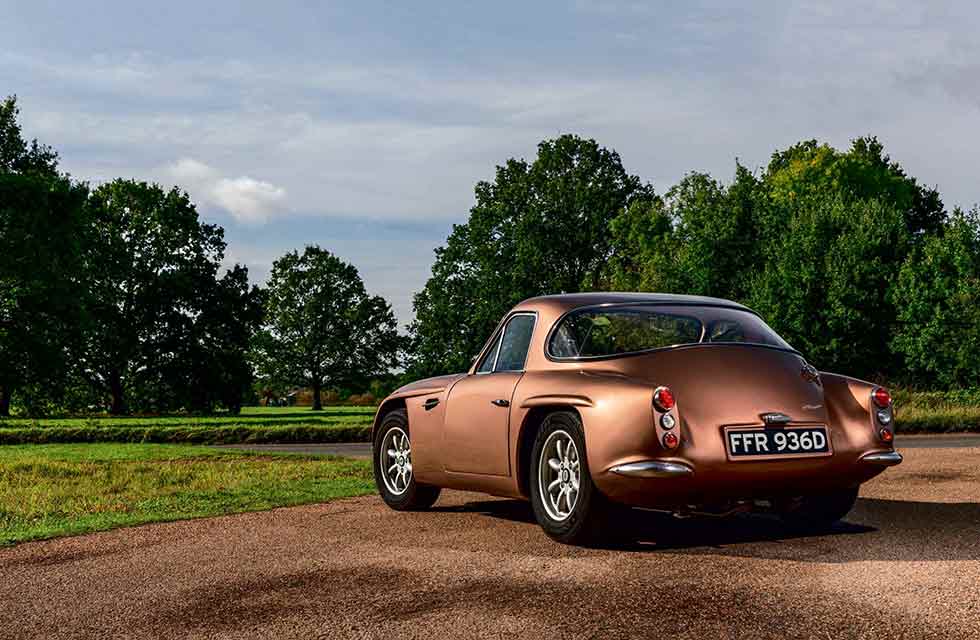
Third-time-lucky owner after five decades Martin Cliffe has owned this TVR Grantura three times – as a nearly new car, a hopeless wreck and as someone else’s part-finished project. Now, at last, it’s as-new again. Words Nigel Boothman. Photography Jarowan Power.
Third time lucky
The chicken wire was a lowpoint,’ says Martin.
We’re looking at old photos on Martin Cliffe’s desk in the oak-framed barn at his family business, Omicron Engineering Ltd, the classic Lancia specialist. And there, in the album, is a TVR with its right buttock made from filler, glassfibre and chicken wire.

‘This was in about 1998,’ he says. ‘I’d just reacquired the car and I was discovering the extent of the damage. And also the misguided attempts to fix it. Look, there are bits of wood in there as well.’
It is a world-class piece of bodgery but it’s out of sequence for our story. Despite being more than 20 years ago, this is comparatively recent history for Martin and his TVR. To find out how the tale began, we need to slip back to the 1960s and meet a man called Carl Smith.
He was a trimmer at TVR’s factory in Blackpool. He began building this car around 1963, Martin believes, but didn’t register it until 1966. The car’s unusual mixture of features – a Griffith bonnet, late Mklll tail treatment and other details – all point to something built using a mix of new and used parts, as confirmed by the local authority registration document that Martin found.
‘Some of the problems had been sorted out by another specialist but there was a good deal left to do. So began a labour of love’
Were some of these parts in lieu of payment? For TVR, financial trouble was never far away, the firm suffered its first liquidation in late 1958, soon after launching its first production model, the Grantura. The Grantura used TVR’s own multi-tube backbone chassis with Volkswagen Beetle trailing arms and torsion bars at both ends, giving all-round independent suspension, and changed to wishbones and coil springs from 1962, which made a huge improvement, There was a choice of engines: the underwhelming but cheap Ford sidevalve, the exciting but expensive OHC Coventry Climax, and the sensible compromise of either a Ford 105E unit or the BMC B-series, as found in the MGA.

‘I was living near Manchester at the time,’ says Martin. ‘I often saw a man called John Akers set the FTD at local autocross meetings in his Grantura. I had a Hillman Imp but when I saw the same model as Akers’ car advertised in Exchange and Mart I had to have a look.’
In Blackpool, Martin found a nearly-new car, painted Jaguar bronze and trimmed to the highest standards with red vinyl, red carpets and a pale grey suspended headlining. ‘Carl Smith told me he was selling it to raise money in order to get married. I haggled to £600, I think.’
Martin discovered a 1500cc Wolseley version of the expected 1600cc MG engine, and a very short final drive ratio – it would apparently romp to 60mph just as quickly if you started in second gear rather than first.
‘I fitted a secondhand Mangoletsi cylinder head and put ram pipes on the twin SUs,’ says Martin. ‘It made no difference to the performance but it produced a loud sucking sound. I went along to the Mangoletsi works – they’re now a Fiat and Alfa dealer but started as a respected tuning company in Knutsford – and begged a little alloy badge for the rear of the car.’
Martin enjoyed the Grantura as his daily driver for two years before his head was turned by a Ginetta G4R, another leap onwards in performance and potential from the TVR.
‘I part-exchanged the Grantura for the Ginetta with a man in Lowestoft,’ says Martin. ‘But a week later, the Ginetta caught fire and burned away to nothing, apart from the fuel tank…which was full of petrol!’
Martin lost track of the TVR until he saw an advert for an apparently similar car with a Griffith bonnet in a classic car magazine in 1988. He phoned the dealer, confirmed it really was his old one and was told it was sold. End of that chapter? Not so. Eight years on, the dealer phoned to say that the car had never left his premises, despite having been paid for.

‘I contacted the owner, negotiated the price down to £400 and went to pick up a sorry collection of scrap,’ says Martin. ‘On the way home, I’d arranged to drop in and see Carl Smith, who was by then trimming Rolls-Royces in Crewe. He was quite shocked by its condition but kindly offered to re-trim the interior if I could restore the rest.’
Only fate had other plans. Martin made progress at first, blasting and priming exposed areas of chassis and buying spare parts, but the damage at the rear – and that subsequent bodge with the chicken wire – brought proceedings to a halt. ‘I couldn’t find a mould for the correct late MkIII shape,’ he says. ‘I didn’t want to rebuild it with a Mkll tail, because that’s not how it was when it was new.’
Frustrated by a lack of progress, Martin part-exchanged the TVR for another Ginetta G4R. The dealer in question repaired the TVR’s body by taking a mould from a different MkIII Grantura in stock there and, in 2005, found a customer to sponsor its conversion into a racing car. Martin made contact with him out of interest, having seen photos of an apparently transformed car. But soon after, unbeknown to Martin, the episode ended in tears with a court case over allegedly substandard work to chassis, body and engine.
‘Much later, in 2017, I decided I wanted a Grantura again but couldn’t find anything satisfactory,’ says Martin. ‘I emailed the gentleman who’d last owned it, knowing nothing of all the trouble he’d had, and to my surprise I got a reply saying he still had the car.’ Martin went to see it in June 2017 and heard the sad tale. Some of the problems had been sorted out by another specialist but there was a good deal left to do.
So began a labour of love. Martin has an advantage most of us lack – running a business staffed by classic-car artisans – but you can’t simply hand over personal projects to the team and distract them from their work. So with a few exceptions, Martin used local subcontractors and did a good deal of the work with his own hands.
‘Finally, Martin got the Grantura running in the spring of 2019, and drove it for the first time in 51 years’
‘Removing the rollcage mountings revealed the original bonded-in steel tubes in perfect condition – one of the few pleasant surprises – but around the rear suspension mounting someone had tried to weld over the brazed joints and a lot had to be re-done before I was satisfied.’
Fixing the body was a scary process because it involved taking the car much further from completion in order to get it right, as Martin explains: ‘The body was blasted to remove all the new paint and old filler, plus any loose gelcoat. It looked awful… I needed the brave pills at this stage!’
A glassfibre specialist improved the inadequate repairs to that rear end but, even after it had been made the correct shape once more, Martin had an ordeal trying to fit an oversized Perspex rear window.
‘That was probably the worst job,’ he says. ‘It was a nightmare of offering it up, marking it, cutting the minimum off and repeating the process. My wife Elizabeth got sciatica from holding the thing steady next to the bandsaw.’
The doors rivalled the rear screen for sheer wrist-scraping awkwardness, as the access inside is extremely poor and the aluminium frames had been butchered to fit sliding Perspex side-windows. No-one seemed to know where the winding mechanism came from, either. ‘I stumbled on a local MG Magnette specialist who showed me Magnette rear-door regulators – almost right. I modified them to fit.’ Martin still had a touch-up can of Jaguar Opalescent Metallic Bronze he’d bought in 1966, but a test-spray looked much darker than he remembered. ‘I saw a Peugeot in a colour that looked very close to what I wanted, so I phoned up the local dealer, read them the car’s numberplate and they gave me the paint code.’
While the body repairs and paint were carried out elsewhere, Martin could make progress with the mechanicals, The car had arrived with a full-race MGB engine, which would be inappropriate for road use, so Martin rebuilt it with a Kent Cams high-torque camshaft and new bearings to replace ‘unused ones of doubtful manufacture’, as he puts it. No seats had survived with the car, but Martin still had drawings he’d made of the frames many years before. He made new ones, strengthened with an aluminium shell over the back and then presented to a favourite trimmer for new red vinyl, with carpets to match.
Martin wired the car himself over the 2018 Christmas break and describes this as the most satisfying point in the restoration, when you finally awaken the sleeper as lights, horn and instruments come to life, The dashboard, a new moulding, was panelled by Martin in 3mm black plastic that he coated in 3Ms Dinoc woodgrain film, which perhaps looks too good to be authentically 1960s TVR.
Finally, Martin got the Grantura running in the spring of 2019, and drove it for the first time in 51 years, but… ‘Euphoria was short-lived as it developed a misfire, The centre two exhaust valves in a B-series run hotter than the other two because of the siamesed bores, and whoever built the head should have given them greater clearance in the guides to stop them sticking.’
Martin wanted to reduce the Granturas notorious bump-steer so he cut and shortened the steering rack to improve the attitude of the steering arms. He also changed the spring rates and damper settings to give frequencies of about 112 cycles per minute at the front, 10% more at the rear. Sounds complex, but it’s just a result generated from the mass of the unsprung weight multiplied by the stiffness of the spring.
Has it all worked? ‘Ergonomics’ was not a word familiar to small sporting marques of the 1960s: there is just enough head- and knee-room but a strangely spacious footwell with the pedals huddled tight in the middle, The steering column is angled towards the middle and your left elbow rests on the huge transmission tunnel, a feature TVR pilots of later decades would recognise.
It starts with an eager growl and makes all the expected slurping Weber noises, which act as a warning not to expect an instant pick-up until it’s much warmer. Pottering out on bumpy lanes it almost feels like a pre-war MG, with that flexible steering column and tiny pedals. But then, as the engine warms and the roads improve, we can use a bit more of that long-travel accelerator pedal and it all comes together beautifully. It wants to be driven fairly hard, I think, feeling composed and capable in corners and whizzing up the rev- range through low overall gearing. You need to find a pretty large pothole mid-bend to provoke any bump-steer and, sure enough, the ride is better than expected from such a car, so Martin must have got his sums right.
It’s a joy playing with the short-throw, wide-gate MGA ’box and using this tuned B-series to fling barely 800kg of TVR up the road. But after much fun dashing back and forth, all too soon we’re back at Omicron, where a gentleman has arrived to meet us. This is Geoff Hipperson, the Mayor of the Borough of Kings Lynn and West Norfolk. He went to a car show at RAF Marham in July 2019 and noticed a little bronze TVR with a Mangoletsi badge, just like the car he bought in October 1968. He found Martin, they got talking, and sure enough it’s the same one. The reminiscences continue over lunch in the agreeable village pub.
This car is all about connections to the past, though Martin says he was worried about revisiting old haunts.
‘All along I felt I might find it so crude, slow and uncomfortable in comparison with other cars I’ve driven since, and that I would therefore be horrified. But I’m happy to say it’s better than I could have hoped for. Was it worth it? Definitely, yes.’
Clockwise from top left Engine originally a full-race MGB unit, then modified for road use by Martin; careful work on steering and suspension makes Grantura surprisingly refined; local West Norfolk Mayor (foreground, with Martin) is a former owner. Above and right: Martin Cliffe first owned this Grantura in the 1960s and was reacquainted in 1998 – by which time it had been badly bodged with chicken wire. Today it is in considerably nicer condition – now he’s its owner for a third time…
1966 TVR Grantura (current spec)
Engine 1798cc OHV four-cylinder, twin-choke Weber carburettor
Max Power 118bhp @ 4900rpm
Max Torque 102lb ft @ 3500rpm
Transmission Four-speed manual with overdrive, non-synchro first, rear-wheel drive
Steering Rack and pinion
Suspension Double wishbones, coil springs, hydraulic dampers
Brakes Discs front, drums rear
Weight 787.5kg
Top speed c110mph with current gearing






